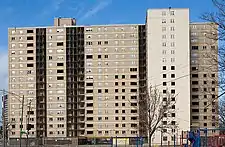Stateway Gardens
Stateway Gardens was a Chicago Housing Authority (CHA) public housing project located in the Bronzeville neighborhood on the South Side of Chicago, Illinois.
| Stateway Gardens | |
|---|---|
 Stateway Gardens in 1979, from the (now) 35th-Bronzeville-IIT stop (CTA Green Line) | |
| General information | |
| Location | Bounded by 35th Street, Pershing Road, State Street, and Federal Street Chicago, Illinois, |
| Coordinates | 41°49′38″N 87°37′40″W |
| Status | Demolished |
| Construction | |
| Constructed | 1955–58 |
| Demolished | 2001–2007 |
| Other information | |
| Governing body | Chicago Housing Authority |
It was located alongside the Dan Ryan Expressway, adjacently north of the former Robert Taylor Homes, and was part of the State Street Corridor that included other CHA properties: Robert Taylor Homes, Dearborn Homes, Harold Ickes Homes and Hillard Homes. Stateway Gardens was home to people living in mid- and high-rise apartment buildings.
Finished by the late 1950s, Stateway Gardens was plagued by a large amount of gang violence, organized crime, and drug abuse. The area gradually became more neglected and underserved by city authorities and the local police department throughout its existence which led to mass abandonment and urban decay. Consequently, the housing project was fully demolished in 2007.
Construction
In 1955, construction at Stateway Gardens commenced, with 1,644 units planned in eight high-rise buildings. The total cost for the project was $22 million. Three years later, construction was complete and approximately 3,000 people moved in. In 1978, a major CHA renovation plan costing $106.2 million was undertaken. This project rehabilitated Stateway Gardens, Robert Taylor Homes and most of the ABLA Homes on Chicago's Near West Side.
Problems and crime
In August, 1984, Stateway Gardens was within the six poorest U.S. census tracts, according to a Roosevelt University study.[1][2] Cabrini–Green on the North Side ranked seventh in the same study. Amid rising crime in CHA developments in the early 1980s, the Chicago Police Department launched a Public Housing Crime Unit to replace private security guards at those sites. In 1988, (prior to the forming of the CHA Police Department) the South Side's Wentworth Police District (which included Stateway Gardens and the Robert Taylor Homes) had 67 homicides, the highest of any district in the city. Stateway Gardens was infamous for its high rate of violent crime and drug activity through the late 1990s.[3][4]
Reorganization
The federal government created Housing Opportunities for People Everywhere (known as HOPE VI) in 1993 as a way to provide funds for cities to demolish dilapidated public-housing units and replace them with mixed-income communities. In 1987, federal officials seized control of all Chicago Housing Authority holdings and property amid allegations of corruption and graft. The CHA would remain under federal receivership until 2010.[5]
Demolition

In 1996, demolition of Cabrini–Green began. This marked the start of what eventually came to be known as the Chicago Housing Authority's Plan for Transformation. One year later, demolition began at the Robert Taylor Homes. In 2000, the CHA formally approved the 10-year Plan for Transformation to remake public housing and demolition began at Stateway Gardens in 2001. In October 2006, families living in the last remaining building (3651–53 S. Federal St.) at Stateway Gardens were scheduled to leave.[1] The building was finally demolished in June 2007, making way for Phase 1 of the mixed income development Park Boulevard, half of which was already completed prior to the demolition and resident relocation processes. The CHA used its One Strike department to determine who would quality for Section 8 relocation.
Notable residents
- Ronnie Lester, University of Iowa All American, NBA Player for Chicago Bulls and Los Angeles Lakers, NBA Scout for Los Angeles Lakers and Phoenix Suns.
References
- Olivo, Antonio (April 16, 2006). "Stateway's Swan Song". Chicago Tribune. Retrieved 8 April 2015.
- "Nation's Poorest Citizens Living in Chicago Housing Developments: Study". Jet. Johnson Publishing Company. February 13, 1995. Retrieved 8 April 2015.
- staff (September 8, 1990). "Suspected Killer Of 3 Is Held Without Bond". Chicago Tribune. Retrieved 8 April 2015.
- staff (June 8, 1995). "30 Are Arrested In Cha Drug Sting". Chicago Tribune. Retrieved 8 April 2015.
- "Judge ends CHA receivership". Crain's Chicago Business. 2010-05-20. Retrieved 2020-07-04.